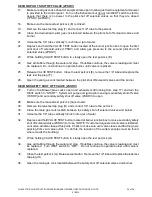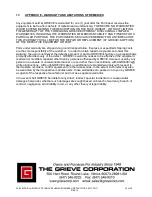
W:\ELECTRICAL\INSTRUCT\FURNACE\FURNACE GENERAL INSTRUCTIONS 2011.DOC
24 of 36
01/2014
8 TROUBLESHOOTING
8-1 NO HEAT
8-1.1 Air flow switch
An air flow switch (which can be located at any blower) may be holding the control
circuit open. The air flow switch senses a pressure differential across the blower.
If there is no pressure differential, the heat control circuit is not closed. If the air
flow switch opens, it will also reset the purge timer (if one exists). Operation and
adjustment of the air flow switch are described on the manufacturer=s literature.
While the switch itself may be defective, an open switch may also be indicating
other problems such as reverse blower rotation, slipping belts, obstructed ductwork,
or a loose pressure connection or electrical connection at the switch itself.
8-1.2 A fuse burned out
In addition to the fuses in your fused disconnect switch, one or more fuses may be
located inside the control panel as shown on the wiring diagram. Depending upon
the particular furnace involved, it is possible for a fuse to open without affecting the
pilot lights (or provide other visible sign) and still affect the heat circuit.
8.2 REDUCED OR INCORRECT FURNACE TEMPERATURE
8-2.1 Excessive Exhaust
Due to incorrect stack installation or unusual pressure conditions, the amount of
heated air removed from the furnace may be excessive and result in a reduced
operating temperature. In this case, the furnace heater will be running
continuously, i.e., 100% output. This can be corrected by closing the exhaust
damper until the maximum operating temperature is achieved. CAUTION: If the
furnace is equipped for use with flammable solvents or is gas heated equipment,
the exhaust capacity must not be reduced below the amount indicated on the
Safety Design Form. See Section 5 - PROCESSING for information on balancing
fresh air and exhaust settings.
8-2.2 Door Leakage
Damaged door gaskets (if applicable) combined with excessive exhaust could
result in cold air being drawn in around the doorway. Replace or repair gaskets
and adjust fresh air inlet. See Section 5 - PROCESSING, for adjustment of fresh
air inlet.
8-2.3 Reduced Blower Speed
Loose or worn drive belts could prevent the recirculating blower (if so equipped)
from attaining its design speed. This results in reduced air flow and inefficient heat
transfer from the heat source to the work space.
8-2.4 Incorrect Blower Rotation
This results in reduced air flow and inefficient heat transfer from the heat source to
the work area. Check blower rotation with respect to arrows located on furnace or
motor mount. Run each blower briefly and watch shaft rotation to ensure correct
rotation. See Section 4 - PRIOR TO PLACING FURNACE IN SERVICE, to correct
blower rotation.
8-2.5 Defective or Improperly Calibrated Temperature Controller
See the temperature controller manufacturer's instructions for the proper operation
and adjustment for the specific controller used.













































